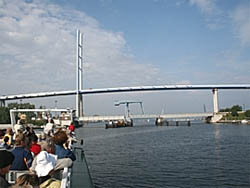
Chancellor Merkel opened a new bridge in Rügen
 |
The new road bridge is set to replace the old network of crossings, Rügendamm, the first sections of which date back to 1936. This included a drawbridge over the Ziegelgraben strait, which had to regularly yield to ships, causing significant delays and long traffic jams.
Local authorities consider the Rügen Bridge vital for the development of local tourism and the economy, so they organized magnificent three-day celebrations for its opening. The ceremony was initiated on Friday by Stralsund's mayor, Harald Lastovka, while the honor of the symbolic opening of the bridge went to Merkel, who was elected to parliament from electoral districts in this region.
"It is an architectural masterpiece allowing for exciting views from the mainland to the island and vice versa,” stated Merkel in the presence of about a thousand guests and around 5,000 local residents during the ceremonial event.
The highlight of the entire celebrations, which are expected to attract about 250,000 people in Stralsund and on the shores of Rügen, will be tonight's fireworks and concerts by popular bands. Until Sunday, the reinforced concrete structure will be open to pedestrians interested in a tour, but on Monday, the first cars will take to the three-lane road.
The real test for the construction work will come in the summer when tourists from all corners of Germany flock to Rügen and Stralsund, which was added to UNESCO's list of World Heritage Sites in 2002. Every year, 1.3 million people spend their vacation on Rügen.
The new connection of the island to the mainland cost the German state treasury 120 million euros (approximately 3.3 billion crowns). The project, which consumed 180,000 tons of concrete and 22,000 tons of steel, took three years to build. It consists of several crossings, viaducts, and ground roads built on an artificial embankment; each section was constructed using different methods, although the overall structure appears cohesive.
The most impressive part of the Rügen Bridge is the crossing of the Ziegelgraben strait between Stralsund and the islet of Dänholm. In this 583-meter-long section, it features a suspension bridge that spans 330 meters over the water surface. The bold structure is suspended on a 128-meter high pylon, from which steel cables fan out in a harp-like fashion. The bridge rises above the sea level at heights of 42 to 50 meters, allowing large cargo ships, built in local shipyards and traveling from here to the rest of the world, to pass underneath it.
However, some technical finesse that permeates the road structure also deserves admiration. Traffic on the road will be monitored by 35 cameras, and traffic on the bridge will be directed from a control center located 150 kilometers away in the town of Petersdorf. For example, the middle lane will be used as needed in one direction or the other, or not at all. In addition to the cameras, 17 light panels with traffic signs have been installed on the bridge to dynamically adjust the direction of travel in each lane and the maximum allowed speed based on traffic density and weather.
The English translation is powered by AI tool. Switch to Czech to view the original text source.
0 comments
add comment










